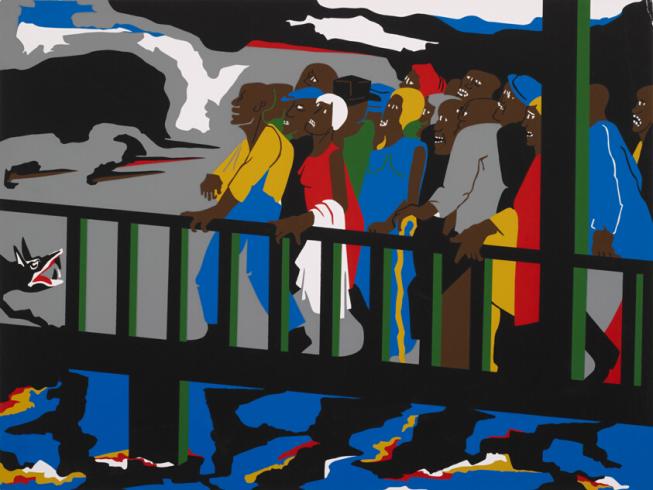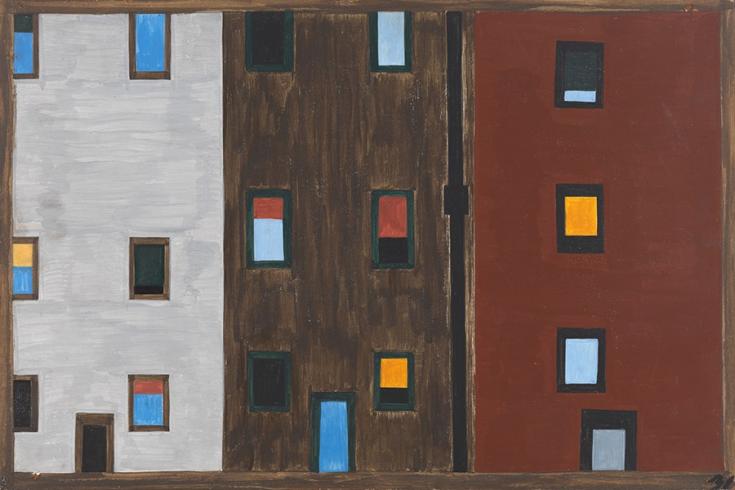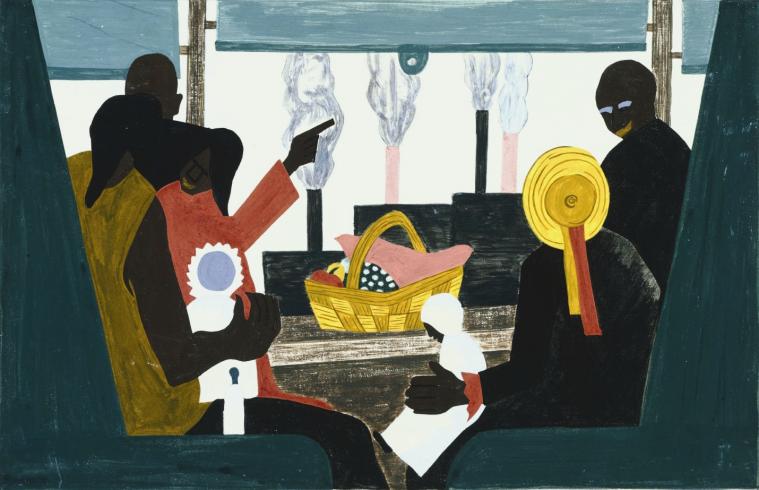Lawrence's Shapes (ECE)

Part 1: Identifying Shapes
Discover:
- Explain to students that Jacob Lawrence was an artist who painted the world around him. He used lots of shapes and lines to show the everyday things he saw ﹘ people, buildings, doors, windows, hats, and luggage. Have students look at:
- Ask students:
- What do you see? What did Lawrence draw?
- Do you recognize any shapes? Which shapes?
- On large chart paper, show students a picture of a triangle, square, rectangle, circle.
- Explain:
- A triangle has three sides
- A square has four equal sides - the sides are the same length
- A rectangle has four sides - two short sides and two long sides
- A circle has no sides
- Go back to the two panels and ask students if they see any of the shapes they discussed.
Part 2: A Closer Look
- For 3 year olds:
- Show the paintings in the shape scavenger hunt and do the activity as a whole class.
- For 4 year olds:
- Explain to students that they will work with their partners to go on a shape scavenger hunt.
- Have students complete the shape scavenger hunt.
Part 3: Artmaking
- Before the lesson, pre-cut shapes using this shapes sheet.
- Have students create their own art using different kinds of shapes. Give the pre-cut shapes to the students.
- Students should pick something they see in their neighborhood every day (ex: apartment building, house, cars, buildings, garden, bus stop).
- Using construction paper, glue, and crayons or markers, students will create their selected neighborhood scene using only the shapes they learned about in class.
Share:
- Students present their art pieces. They should:
- Discuss the neighborhood scene they created
- Identify the different shapes they used
Additional Context
Lesson Context
“I tried to create a staccato-like rhythm over and over and over again [with] the shapes as they move…I build on the geometry and I love it.”–Jacob Lawrence
In 1940, Jacob Lawrence rented his first studio to prepare and lay out the 60 panels that would comprise The Migration Series. Lawrence drew all 60 compositions before beginning to paint. He then painted the series all at once, color by color—starting with ivory, black, and burnt-umber browns, and moving to cadmium red, orange, and yellow. The limited color palette and Lawrence’s technique of applying colors one at a time across the series enabled him to keep the panels consistent and bring together the work cohesively.
Lawrence created his panels using shapes of even, matte color. To create a strong effect, he put contrasting colors next to each other and used bold patterns to create a more dramatic effect. To make his art feel like it was moving, he used many two-dimensional shapes with strong diagonal lines (like triangles). The light and dark colors next to each other created contrast. This process helped to express a mood and story throughout the panels.
One of his first art teachers, Charles Alston, an African-American painter and educator whose art explored racial identity as well as the personal and common aspects of the Black experience, encouraged Lawrence to see and express the geometric shapes and patterns present in everyday life. Alston encouraged Lawrence to look at parts of his everyday life ranging from the decor of his family’s apartment to the streets of New York.
Key Terms
Geometric shapes: Shapes such as triangles, squares, rectangles, circles, trapezoids. We don’t often see them in the natural, outside world. They usually have straight lines and angles.


